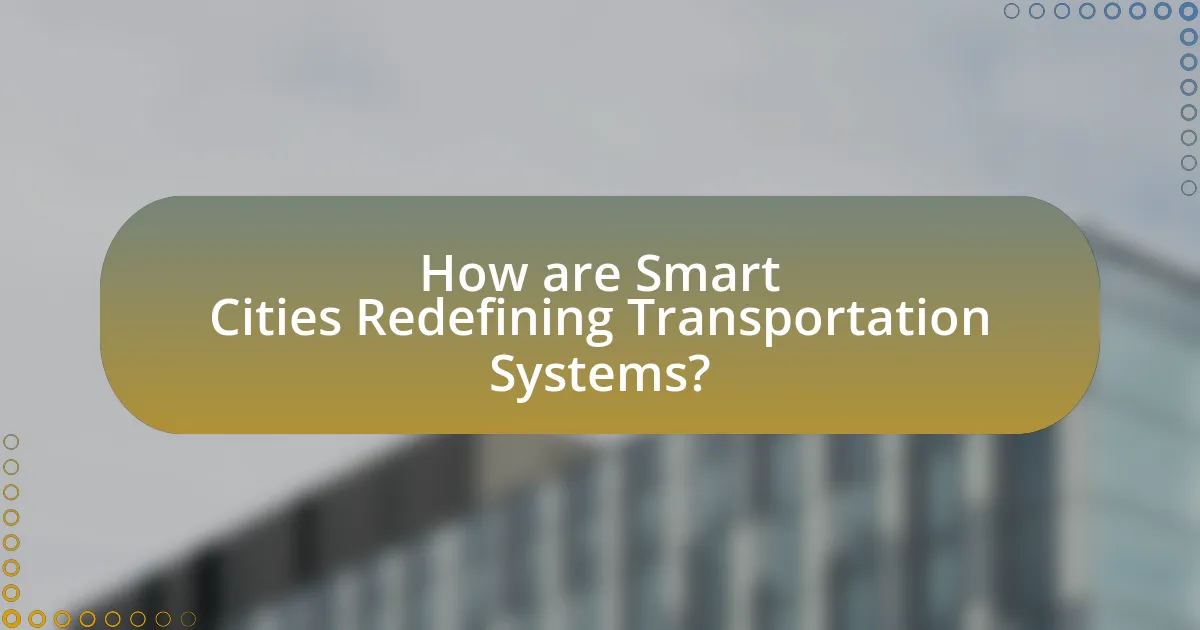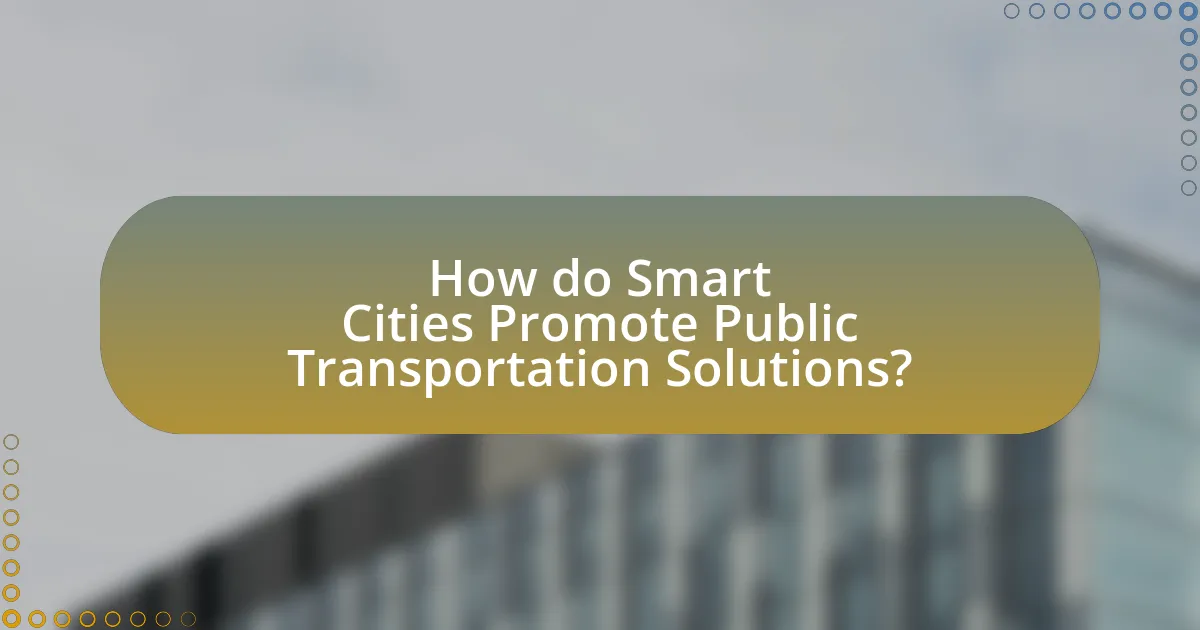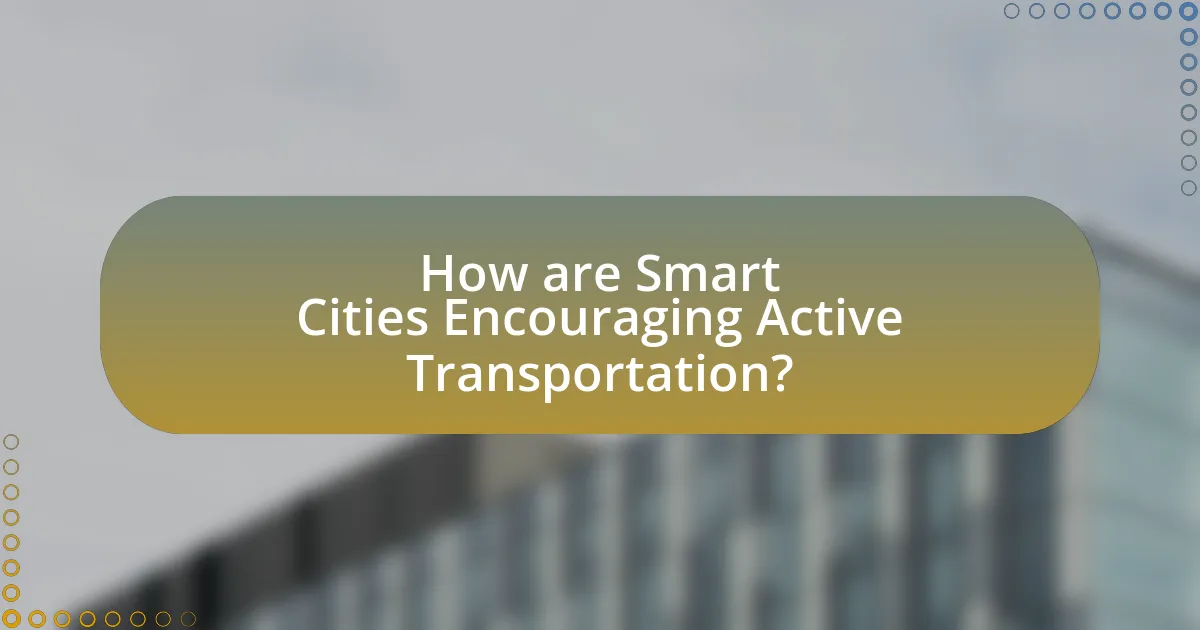Smart cities are transforming transportation systems by integrating advanced technologies and data analytics to improve efficiency, sustainability, and user experience. Key innovations include smart traffic management systems that optimize traffic flow, promote electric and shared mobility solutions, and enhance public transportation options. The article explores the role of technology and data in urban mobility, the benefits of sustainable transportation, and the challenges faced by cities in implementing these systems. Additionally, it discusses the impact of active transportation on public health and outlines best practices for sustainable transportation planning. Overall, smart cities are redefining urban mobility to create interconnected, efficient, and environmentally friendly transportation networks.

How are Smart Cities Redefining Transportation Systems?
Smart cities are redefining transportation systems by integrating advanced technologies and data analytics to enhance efficiency, sustainability, and user experience. These urban environments utilize smart traffic management systems, which leverage real-time data to optimize traffic flow, reduce congestion, and minimize travel times. For instance, cities like Barcelona have implemented smart traffic lights that adapt to real-time traffic conditions, resulting in a reported 20% reduction in travel time. Additionally, smart cities promote the use of electric and shared mobility solutions, such as electric buses and bike-sharing programs, which contribute to lower emissions and improved air quality. According to a report by the International Transport Forum, cities that adopt smart transportation solutions can reduce greenhouse gas emissions by up to 30%. Overall, smart cities are transforming transportation by creating interconnected, efficient, and environmentally friendly systems.
What role do technology and data play in smart city transportation?
Technology and data are crucial in optimizing smart city transportation by enhancing efficiency, safety, and sustainability. Smart traffic management systems utilize real-time data analytics to monitor traffic flow, reducing congestion and improving travel times. For instance, cities like Barcelona have implemented smart traffic lights that adapt to real-time traffic conditions, resulting in a 20% reduction in travel time. Additionally, data from public transportation systems allows for better route planning and scheduling, increasing ridership and reducing carbon emissions. The integration of Internet of Things (IoT) devices enables continuous data collection, facilitating predictive maintenance of transportation infrastructure, which can decrease operational costs by up to 30%. Overall, technology and data drive the transformation of urban mobility, making it more responsive to the needs of citizens while promoting environmental sustainability.
How do sensors and IoT devices enhance transportation efficiency?
Sensors and IoT devices enhance transportation efficiency by providing real-time data that optimizes traffic flow and reduces congestion. These technologies enable smart traffic management systems to analyze vehicle movement, monitor road conditions, and adjust traffic signals accordingly, leading to smoother transit experiences. For instance, a study by the Institute of Transportation Engineers found that cities implementing IoT-based traffic management saw a 20% reduction in travel time and a 15% decrease in fuel consumption. This data-driven approach not only improves the efficiency of transportation networks but also contributes to lower emissions and enhanced urban mobility.
What types of data are collected to improve urban mobility?
To improve urban mobility, cities collect various types of data including traffic flow data, public transportation usage statistics, pedestrian movement patterns, and environmental data. Traffic flow data, gathered through sensors and cameras, helps identify congestion points and optimize signal timings. Public transportation usage statistics, collected from ticket sales and mobile apps, inform service frequency and route adjustments. Pedestrian movement patterns, tracked via mobile location data, assist in designing safer walkways and crossings. Environmental data, such as air quality measurements, supports initiatives aimed at reducing emissions and promoting sustainable transport options. These data types collectively enhance urban mobility by enabling informed decision-making and efficient resource allocation.
Why is sustainable transportation important in smart cities?
Sustainable transportation is crucial in smart cities because it reduces environmental impact and enhances urban livability. By prioritizing eco-friendly modes of transport, such as public transit, cycling, and walking, smart cities can significantly lower greenhouse gas emissions and air pollution levels. For instance, a study by the International Council on Clean Transportation found that cities implementing sustainable transport initiatives can reduce emissions by up to 30% over a decade. Additionally, sustainable transportation improves accessibility and mobility, fostering economic growth and social equity within urban areas.
How does sustainable transportation contribute to environmental goals?
Sustainable transportation significantly contributes to environmental goals by reducing greenhouse gas emissions and minimizing air pollution. For instance, the use of electric vehicles and public transit systems decreases reliance on fossil fuels, which are major contributors to climate change. According to the International Energy Agency, transitioning to electric vehicles could reduce global CO2 emissions by up to 1.5 gigatons annually by 2030. Additionally, promoting cycling and walking in urban areas not only lowers emissions but also enhances urban air quality, leading to healthier communities. Therefore, sustainable transportation directly aligns with environmental objectives by fostering cleaner air and mitigating climate change impacts.
What are the social benefits of sustainable transportation in urban areas?
Sustainable transportation in urban areas enhances social equity by providing accessible mobility options for all demographics, including low-income individuals and those with disabilities. This inclusivity fosters community engagement and social interaction, as public transit systems and pedestrian-friendly infrastructure encourage people to connect and participate in local activities. Furthermore, sustainable transportation reduces air pollution and traffic congestion, leading to improved public health outcomes, which is evidenced by studies showing a correlation between reduced vehicle emissions and lower rates of respiratory diseases in urban populations. Additionally, the promotion of cycling and walking contributes to a sense of community and belonging, as neighborhoods become more vibrant and interconnected.
What challenges do smart cities face in implementing sustainable transportation?
Smart cities face several challenges in implementing sustainable transportation, including infrastructure limitations, funding constraints, and public acceptance. Infrastructure limitations arise from the need to upgrade existing transportation systems to accommodate new technologies, such as electric vehicle charging stations and dedicated lanes for public transit. Funding constraints often hinder the development of sustainable projects, as cities must compete for limited financial resources and prioritize various initiatives. Public acceptance is crucial, as residents may resist changes to their transportation habits or the introduction of new systems, impacting the overall effectiveness of sustainable transportation initiatives. These challenges collectively impede the progress of smart cities in achieving their sustainability goals.
How do funding and investment impact transportation projects?
Funding and investment significantly influence transportation projects by determining their scope, quality, and sustainability. Adequate financial resources enable the development of advanced infrastructure, such as smart traffic management systems and eco-friendly public transit options, which are essential for smart cities. For instance, a study by the American Society of Civil Engineers reported that every dollar invested in public transportation generates approximately four dollars in economic returns, highlighting the critical role of funding in enhancing project viability and community benefits. Additionally, investment in innovative technologies can lead to improved efficiency and reduced environmental impact, aligning with the goals of sustainable transportation in urban settings.
What are the barriers to public acceptance of new transportation technologies?
Barriers to public acceptance of new transportation technologies include concerns about safety, lack of trust in technology, high costs, and insufficient public awareness. Safety concerns arise from fears of accidents or malfunctions, as seen in the hesitance towards autonomous vehicles following incidents reported in media. Lack of trust in technology is evident when individuals question the reliability and security of new systems, often influenced by past failures in tech implementations. High costs deter adoption, as many new technologies require significant investment from both consumers and municipalities, which can be a barrier in budget-constrained environments. Lastly, insufficient public awareness leads to skepticism; studies show that communities with limited information about new technologies are less likely to embrace them, highlighting the need for effective communication strategies to educate the public.

How do Smart Cities Promote Public Transportation Solutions?
Smart cities promote public transportation solutions by integrating advanced technologies and data analytics to enhance efficiency and accessibility. These cities utilize real-time data to optimize transit routes, reduce wait times, and improve service reliability, which encourages higher public transit usage. For instance, cities like Barcelona and Singapore have implemented smart traffic management systems that adjust signal timings based on current traffic conditions, leading to smoother public transport operations. Additionally, smart cities often invest in infrastructure such as dedicated bus lanes and multimodal transport hubs, facilitating seamless transfers between different modes of transport. This strategic focus on technology and infrastructure not only enhances user experience but also contributes to reduced traffic congestion and lower carbon emissions, aligning with sustainability goals.
What innovative public transportation models are emerging in smart cities?
Innovative public transportation models emerging in smart cities include autonomous shuttles, on-demand transit services, and integrated mobility platforms. Autonomous shuttles, such as those tested in cities like San Francisco and Las Vegas, utilize advanced sensors and AI to navigate urban environments without human drivers, enhancing safety and efficiency. On-demand transit services, exemplified by apps like Uber and Lyft, allow users to request rides in real-time, optimizing routes based on current demand and reducing wait times. Integrated mobility platforms, such as those developed in cities like Barcelona, combine various transportation modes—buses, bikes, and ride-sharing—into a single app, facilitating seamless travel and reducing reliance on personal vehicles. These models are supported by data analytics and IoT technologies, which improve operational efficiency and user experience.
How do on-demand transit services work in urban environments?
On-demand transit services operate in urban environments by utilizing technology to connect passengers with vehicles in real-time, allowing for flexible routing and scheduling. These services typically rely on mobile applications that enable users to request rides, which are then matched with nearby drivers or vehicles, optimizing routes based on current demand and traffic conditions. For instance, a study by the Transportation Research Board found that on-demand services can reduce wait times and improve overall efficiency in public transportation systems, demonstrating their effectiveness in urban settings.
What is the role of autonomous vehicles in public transportation?
Autonomous vehicles play a transformative role in public transportation by enhancing efficiency, safety, and accessibility. These vehicles can operate without human intervention, allowing for optimized routing and reduced operational costs. For instance, a study by the American Public Transportation Association indicates that autonomous shuttles can increase ridership by providing first-mile and last-mile connectivity, thereby integrating seamlessly with existing transit systems. Additionally, autonomous vehicles can reduce traffic accidents caused by human error, as they utilize advanced sensors and algorithms to navigate safely. This shift towards automation in public transport aligns with the goals of smart cities, which aim to create sustainable and efficient urban mobility solutions.
How do smart cities integrate various modes of transportation?
Smart cities integrate various modes of transportation through the use of advanced technologies and data analytics to create a seamless mobility experience. This integration involves real-time data sharing among public transit systems, ride-sharing services, bicycles, and pedestrian pathways, enabling users to plan their journeys efficiently. For instance, cities like Barcelona utilize smart traffic management systems that optimize traffic flow and reduce congestion by coordinating signals and providing real-time updates to commuters. Additionally, the implementation of mobile applications allows users to access multiple transportation options, such as buses, trains, and bike-sharing services, all in one platform, enhancing accessibility and convenience.
What are the benefits of multimodal transportation systems?
Multimodal transportation systems enhance efficiency, reduce congestion, and promote sustainability in urban environments. By integrating various modes of transport, such as buses, trains, bicycles, and walking paths, these systems provide flexible options for commuters, leading to decreased reliance on single-occupancy vehicles. Studies indicate that cities implementing multimodal strategies experience a significant reduction in traffic congestion, with some reporting up to a 30% decrease in peak-hour traffic. Additionally, multimodal systems contribute to lower greenhouse gas emissions, as they encourage the use of public transport and non-motorized options, aligning with sustainability goals in smart city initiatives.
How does technology facilitate seamless transfers between transport modes?
Technology facilitates seamless transfers between transport modes by integrating real-time data, mobile applications, and automated systems that enhance connectivity and user experience. For instance, smart ticketing systems allow passengers to use a single payment method across various transport modes, reducing the need for multiple tickets and simplifying the transfer process. Additionally, real-time tracking applications provide users with up-to-date information on schedules and delays, enabling them to plan their journeys more effectively. Research from the International Transport Forum indicates that cities implementing integrated transport systems see a 20% increase in public transport usage, demonstrating the effectiveness of technology in promoting seamless transfers.
What impact does public transportation have on urban sustainability?
Public transportation significantly enhances urban sustainability by reducing greenhouse gas emissions and minimizing traffic congestion. Studies indicate that cities with robust public transit systems can lower per capita carbon emissions by up to 45% compared to those reliant on personal vehicles. Furthermore, efficient public transportation encourages higher density development, which conserves land and resources. For instance, the American Public Transportation Association reports that public transit saves approximately 4.2 billion gallons of gasoline annually, contributing to energy conservation and improved air quality. Thus, public transportation is a critical component in fostering sustainable urban environments.
How does increased public transit usage reduce carbon emissions?
Increased public transit usage reduces carbon emissions by decreasing the number of individual vehicles on the road, which lowers overall greenhouse gas emissions. Public transit systems, such as buses and trains, can transport many passengers simultaneously, leading to a significant reduction in per capita emissions. For instance, the American Public Transportation Association reports that public transit saves approximately 45 million metric tons of carbon dioxide annually, equivalent to the emissions from over 9 million cars. This efficiency in transportation contributes to cleaner air and a reduction in urban congestion, further enhancing sustainability efforts in smart cities.
What are the economic advantages of investing in public transportation?
Investing in public transportation yields significant economic advantages, including increased accessibility, reduced traffic congestion, and enhanced property values. Public transportation systems facilitate easier access to jobs and services, which can lead to higher employment rates and economic productivity. For instance, a study by the American Public Transportation Association found that every $1 invested in public transportation generates approximately $4 in economic returns. Additionally, improved public transit reduces traffic congestion, which can save commuters time and decrease costs associated with vehicle operation. Furthermore, areas with robust public transportation often see increased property values, as proximity to transit options is a desirable feature for homebuyers.

How are Smart Cities Encouraging Active Transportation?
Smart cities are encouraging active transportation by implementing integrated infrastructure that supports walking and cycling, such as dedicated bike lanes, pedestrian-friendly pathways, and improved public transit options. These cities utilize smart technology to monitor traffic patterns and optimize routes, making active transportation safer and more efficient. For instance, cities like Amsterdam and Copenhagen have seen significant increases in cycling due to investments in bike-sharing programs and extensive cycling networks, leading to a reported 40% of trips made by bike in these areas. Additionally, smart cities promote awareness campaigns and provide real-time data on air quality and traffic conditions, further incentivizing residents to choose active transportation methods.
What initiatives promote walking and cycling in urban areas?
Initiatives that promote walking and cycling in urban areas include the development of dedicated bike lanes, pedestrian-friendly infrastructure, and public awareness campaigns. Cities like Copenhagen have implemented extensive cycling networks, resulting in over 60% of residents commuting by bike daily. Additionally, programs such as “Open Streets” events temporarily close roads to vehicles, encouraging walking and cycling. Research shows that cities investing in such initiatives experience reduced traffic congestion and improved public health outcomes, reinforcing the effectiveness of these strategies in fostering sustainable transportation.
How do bike-sharing programs contribute to sustainable transportation?
Bike-sharing programs contribute to sustainable transportation by reducing reliance on motor vehicles, thereby decreasing greenhouse gas emissions and traffic congestion. These programs promote cycling as an eco-friendly alternative, which can lead to a significant reduction in urban air pollution; for instance, a study by the Institute for Transportation and Development Policy found that bike-sharing can reduce carbon emissions by up to 50% in cities with high usage rates. Additionally, bike-sharing systems often integrate with public transit, enhancing overall mobility and encouraging a shift towards more sustainable travel behaviors.
What infrastructure improvements support pedestrian-friendly environments?
Infrastructure improvements that support pedestrian-friendly environments include the development of wide sidewalks, pedestrian-only zones, improved crosswalks, and the installation of traffic calming measures. Wide sidewalks enhance the walking experience by providing ample space for pedestrians, while pedestrian-only zones eliminate vehicle traffic, making areas safer and more enjoyable for walking. Improved crosswalks, equipped with signals and clear markings, increase safety and accessibility for pedestrians. Traffic calming measures, such as speed bumps and raised intersections, reduce vehicle speeds, further enhancing pedestrian safety. These improvements are supported by studies indicating that pedestrian-friendly infrastructure leads to increased foot traffic, economic benefits for local businesses, and improved public health outcomes through increased physical activity.
How do smart technologies enhance active transportation safety?
Smart technologies enhance active transportation safety by integrating real-time data and communication systems that improve awareness and response to hazards. For instance, smart traffic signals can adapt to pedestrian and cyclist movements, reducing the likelihood of accidents. Additionally, connected vehicle technology allows for communication between vehicles and infrastructure, alerting drivers to the presence of cyclists or pedestrians in their vicinity. Studies show that cities implementing smart technologies, such as adaptive traffic management systems, have seen a reduction in accidents involving vulnerable road users by up to 30%. This data underscores the effectiveness of smart technologies in creating safer environments for active transportation.
What role do mobile apps play in promoting walking and cycling?
Mobile apps play a crucial role in promoting walking and cycling by providing users with navigation, tracking, and community engagement features. These applications facilitate route planning, helping users find safe and efficient paths for walking and cycling, which encourages more people to choose these modes of transportation. For instance, studies show that apps like Strava and MapMyRun have increased user engagement in physical activities, with Strava reporting over 50 million users who log their cycling and walking activities, fostering a sense of community and competition. Additionally, mobile apps often include gamification elements, such as challenges and rewards, which further motivate individuals to walk or cycle more frequently.
How can smart traffic management systems improve safety for cyclists and pedestrians?
Smart traffic management systems enhance safety for cyclists and pedestrians by utilizing real-time data to optimize traffic flow and reduce accidents. These systems employ sensors and cameras to monitor traffic conditions, allowing for adaptive signal control that prioritizes the movement of vulnerable road users. For instance, studies have shown that cities implementing smart traffic systems have experienced a reduction in pedestrian and cyclist injuries by up to 30%. Additionally, features such as dedicated bike lanes and pedestrian crossings can be dynamically adjusted based on traffic patterns, further minimizing risks. This data-driven approach not only improves safety but also encourages more people to choose cycling and walking as viable transportation options, contributing to sustainable urban mobility.
What are the health benefits associated with active transportation in smart cities?
Active transportation in smart cities significantly enhances public health by promoting physical activity and reducing air pollution. Engaging in walking, cycling, or using public transit encourages regular exercise, which is linked to lower rates of obesity, cardiovascular diseases, and diabetes. For instance, a study published in the American Journal of Preventive Medicine found that individuals who actively commute are 50% more likely to meet recommended physical activity levels compared to those who do not. Additionally, smart city initiatives often include improved infrastructure for active transportation, such as bike lanes and pedestrian pathways, which further incentivizes these healthy behaviors. Furthermore, reduced reliance on motor vehicles leads to decreased emissions, contributing to better air quality and lower respiratory issues among residents.
How does active transportation impact public health outcomes?
Active transportation significantly improves public health outcomes by promoting physical activity, which reduces the risk of chronic diseases. Engaging in activities such as walking or cycling increases cardiovascular fitness, lowers obesity rates, and enhances mental well-being. Research indicates that communities with higher rates of active transportation experience lower incidences of heart disease, diabetes, and depression. For instance, a study published in the American Journal of Preventive Medicine found that individuals who walk or bike regularly have a 30% lower risk of developing heart disease compared to those who do not engage in such activities. Thus, active transportation serves as a crucial factor in enhancing overall public health.
What strategies can cities implement to encourage more active commuting?
Cities can implement strategies such as developing dedicated cycling lanes, enhancing pedestrian infrastructure, and promoting public awareness campaigns to encourage more active commuting. Dedicated cycling lanes provide safe routes for cyclists, which can increase the number of people choosing to bike; for instance, cities like Copenhagen have seen a 62% increase in cycling due to such infrastructure. Enhancing pedestrian infrastructure, including wider sidewalks and safe crossings, encourages walking by making it more accessible and pleasant. Public awareness campaigns can inform residents about the health and environmental benefits of active commuting, as evidenced by studies showing that cities with active transportation initiatives report higher levels of physical activity among residents.
What best practices can cities adopt for sustainable transportation planning?
Cities can adopt several best practices for sustainable transportation planning, including the development of integrated public transit systems, promotion of non-motorized transport, and implementation of smart technology solutions. Integrated public transit systems enhance connectivity and accessibility, reducing reliance on personal vehicles; for instance, cities like Amsterdam have successfully integrated cycling with public transport, leading to a significant decrease in carbon emissions. Promoting non-motorized transport, such as walking and cycling, encourages healthier lifestyles and reduces traffic congestion, as seen in Copenhagen, where extensive bike lanes have increased cycling rates by over 30%. Additionally, implementing smart technology solutions, such as real-time traffic management and electric vehicle charging infrastructure, can optimize traffic flow and reduce emissions, as demonstrated by cities like Los Angeles, which has invested in smart traffic signals to improve efficiency. These practices collectively contribute to a more sustainable urban transportation framework.


